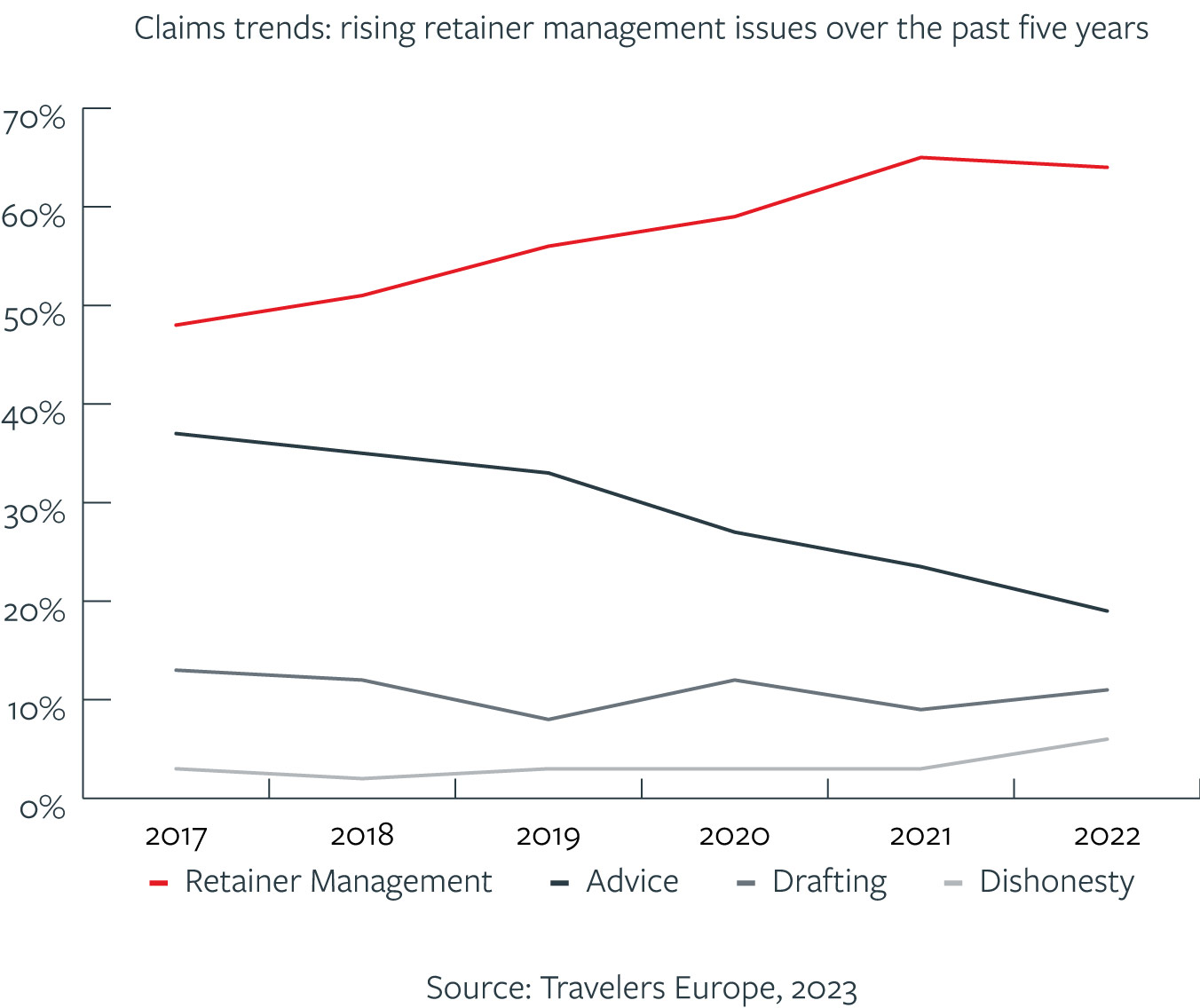- Professional Indemnity Insurance


UK: Law Firms and Lawyers Must Reconsider Their Risks
Do you see yourself as a risk-taker? There is a common perception that lawyers are averse to risk. After all, they are in the business of helping clients anticipate what might go wrong and protecting them against that possibility. But the real-life workings of a law firm demonstrates a far different response to risks.
Law firms are competitive environments – and firms must take risks in order to compete. The past few years alone have ushered in more change to the profession than it has experienced in many decades. Firms have had to adapt their practices to cyber risk, disaster recovery, ESG and employee wellbeing. Technology advancements, including the influence of artificial intelligence, have also required law firms to adapt – and against a backdrop of high inflation, heightened regulation, and geopolitical tensions.
It’s not an environment suited to people averse to risk and it is an environment that can generate a lot of late-night worry for leaders of law firms. For firms to be in the best position to compete, they must manage the risk, which in turn should reduce the concerns. The good news is that some of the risks law firms and lawyers face are within their control – and with the right management, these risks can create opportunities.
Manage the mindset
Let’s start with what keeps lawyers up at night. Lawyers are a driven class of professionals and their work ambitions may generate negative consequences along with positive ones.
“Lawyers enter the profession knowing they are going to work hard,” said Paul Smith, Senior Risk Management Consultant at Travelers Europe. “They are going to deal with stressful situations, and if every hour is an opportunity to make money, there is a tendency to work longer hours.”
The Life in the Law Report 2020/21, commissioned by LawCare, highlighted the personal dangers high levels of work intensity (high workload and working long hours) with both associated with instances of burnout[1]
This perspective on work can be problematic. Indeed, the potential for slips or lapses in concentration from fee earners increases with the (often accepted) pressures of the legal profession. This can, and is, resulting in rising occurrences of Retainer Management failure within law firms.
“These errors are often very simple – not following instructions, taking the wrong step in a process, or making a drafting error, for example,” Smith said. “But these errors say a lot about the environment in which legal professionals work. When these kinds of claims happen, they are not the result of a failure of advice but rather the result of distraction driven by stress, pressure and fatigue. If people are pushed to the limit, they will make mistakes. These claims have been scaling up rather remorselessly over the past five years – not just over COVID.”
Claims trends: rising retainer management issues over the past five years
 Source: Travelers Europe, 2023
Source: Travelers Europe, 2023
The pressures creating the conditions for these claims require action not just from lawyers but from their firms as well. In the absence of firm leaders’ commitment to protecting mental wellbeing, fee earners can feel that emotional health is yet another responsibility they must manage – or risk feeling like a failure if they do not.
New research reflects this reality: According to the 2023 ALM and Law.com Compass Mental Health Survey of the Legal Profession, lawyers report experiencing an increase in stress, anxiety and depression – even though the legal profession has been increasing its focus on mental health and developing initiatives intended to support it.[2] About 71% of the nearly 3,000 lawyers surveyed this year said they had anxiety, which represents a 5% increase from 2022, according to the American Lawyer.[3]
But for firms that successfully bridge the disconnect between wellbeing initiatives and employee mental health, there are opportunities. Research from Deloitte found that for every pound that employers invest in employees’ mental health, they receive an average return of £5.30. [4]
Consider structural shifts
In the risk-heavy business climate in which law firms operate, risk taking is required to compete. But it also requires firms to more carefully balance perceived risks – which can be significant – against potential rewards. Across your firm, are there pockets of risk-averse thinking, along with other areas that could benefit from more risk-taking and innovation? If so, lay the foundation for greater diversity of thought. In the complex business environment in which firms are operating today, groupthink is common – and it can lead to organisations overlooking both risks and opportunities. Shifting away from working in silos can open up decision making so people can see an issue from new perspectives and better understand the firm’s risks.
Graeme Miller, CEO of the risk management tech firm Riskoncise, says this approach can help firms avoid wasting time, help lawyers perform better, bolster their decisions with instructive patterns, and increase profitability through reducing non-billable prep work and repetition. It improves a firm’s culture and can help an organisation become more risk aware, less risk averse, and better able to take risks with optimism.
It can also strengthen the partnership between a law firm and their insurer – and, in turn, prepare a firm to seize new opportunities. When an insurer is part of the conversation about how their client firm is running their business, how they are managing their people, and what new ventures they are considering, they can help the firm anticipate potential difficulties that can arise in different parts of the business and ensure they don’t swell into distracting problems. It’s a symbiotic relationship.
“Insurers are of course alert to the risks of uncertainty and are always interested when it is our law firm clients taking those steps into the unknown,” said Sharon Glynn, Director at Travelers Europe. “But a law firm that closes its eyes to change and risk can be as much of a concern as one that runs full speed towards it. If a firm locks the doors and pulls down the blinds in the face of uncertainty, what does that say about its resilience, attitudes about innovation, and ability to change and seize opportunities? For everything we know about law firms and their operations, there is always more to learn.”
The information provided in this article is intended for use as a guideline and is not intended as, nor does it constitute, legal or professional advice. Travelers does not warrant that the information in this article constitutes a complete and finite list of each and every item or procedure related to the topics or issues referenced herein. Travelers does not warrant that adherence to, or compliance with, any recommendations, best practices, checklists, or guidelines will result in a particular outcome.
[1] https://www.lawcare.org.uk/media/14vhquzz/lawcare-lifeinthelaw-v6-final.pdf
[2] https://www.abajournal.com/news/article/mental-health-initiatives-arent-curbing-lawyer-stress-and-anxiety-new-study-shows
[3] https://www.law.com/americanlawyer/2023/05/18/mental-health-by-the-numbers-an-infographic-mapping-the-legal-industrys-wellbeing/?slreturn=20230701064141
[4] https://www2.deloitte.com/uk/en/pages/press-releases/articles/poor-mental-health-costs-uk-employers-up-to-pound-56-billion-a-year.html
The Knowledge Newsletter
Subscribe to The Knowledge for a no-nonsense view into the latest research and trends before it makes its way to our blog.
We will only use your email address to send you this newsletter. You can unsubscribe at any time. Privacy Policy













